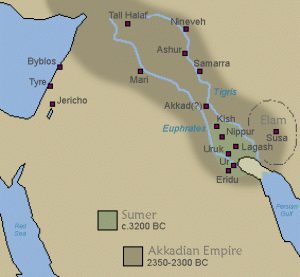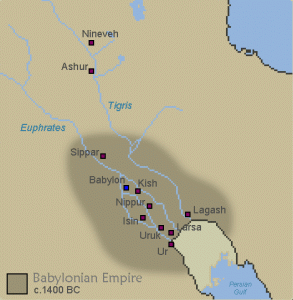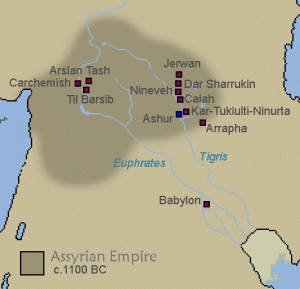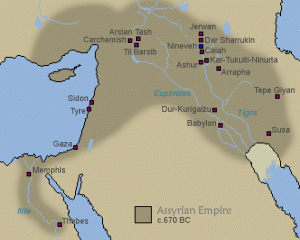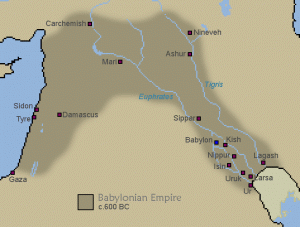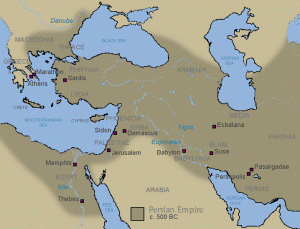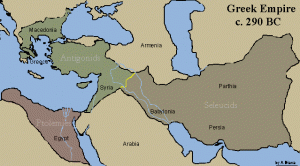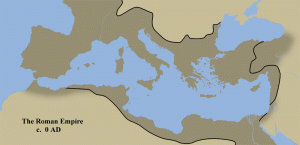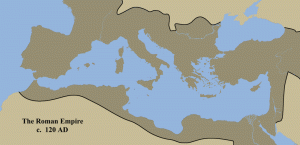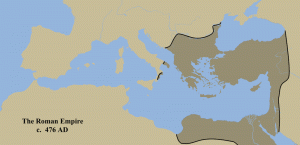A Brief History
- Aramaeans – Semitic tribe who settled in Syria, near the Babylonia/Assyria border along the Euphrates (c. 1100).
- Chaldeans – Semitic tribe from wetlands (“Sealand”) in S Babylonia (c. 800).
- Hurrians – ???
- Elam – Develops just SE of Mesopotamia c.6000 BC (modern Iran). Capital at Susa.
- Canaan – Develops in Palestine c.3200 BC, but nearby Jericho is far older, perhaps by several thousand years.
- Phoenicia – A Seafaring people of Canaanite origin, develops N of Canaan (Lebanon) c.1200 BC.
- Lydia – Indo-Europeans ???, settled in W Asia Minor c. 1200 BC. Capital at Sardis.
- Hittites – Develop in Anatolia, SW Asia Minor/NW Syria (modern SE Turkey/NW Syria). Its individual states are joined to form an empire c. 1650 BC.
- Medes – Indo-Europeans, settled in Iranian plateau c.2000 BC (modern Iran/Afghanistan). Capitol at Ecbatana
- Persians – Indo-Europeans, settled in S Iranian plateau c.1000 BC in Parsa, across the mountains, SW of Elam.
- Parthians – Indo-European ??? tribe from NE Iranian plateau, rise c. 250 BC
- Romans – Indo-Europeans, settled in central Italy, c. 800 BC
From City-States to Empires
The first civilizations learned various arts such as farming, working with terracotta, and metal-working, and eventually began trading their surpluses, and often warring with eachother. If united, it usually wasn’t for long, and dominance of any one city-state over others never lasted any appreciable amount of time. This began to change as kings started making attempts to form cohesive empires of the independant states.
- c. 2800 to 2400 – Kish, Uruk, and Ur are the dominant city-states during this time.
- 2375 – Umma’s Lugal-Zagesi defeats long-time enemy Lagash and shortly after rules over all Sumer for a brief period.
- 2334 – Sargon of Akkad (a city-state just North of Sumer) defeats Lugal-Zagesi and proceeds to unite Mesopotamia forming the empire of Sumer-Akkad.
- c. 2220 – The Gutians, a tribe from the mountains, invade and the Akkadian empire disolves back into its constituent city-states.
- 2112 – Shortly after the Gutians are expelled, Ur-Nammu rules over most of Sumer from now-dominant Ur (the so-called 3rd Dynasty of Ur, the last Sumerian dynasty).
- c. 2100 (?) – Jewish patriarch Abraham departs from Ur.
- c. 2000 – Attacks from Elam, constant pressure from the Amorites, and flat out rebellion disolve the Sumerian empire. Ur is destroyed by the Elamites. Isin and Larsa are dominant during this period.
The First Babylonian Empire
The Amorites, a collection of Semitic peoples living West of Mesopotamia, had been migrating into/invading Mesopotamia for some time. Eventually, their people find themselves leading some of the most powerful city-states of the realm.
- c. 1900 – Babylon, a primarily Amorite city, begins to rise in power. This is the beginning of the “Old” Babylonian Empire.
- 1810 – To the North, the kingdom of Assyria is ruled by another Amorite, Shamshi-Adad.
- c. 1800 (?) – The house of Israel begins its long stay in Egypt when Jacob and his sons relocate with Joseph.
- 1760 – The Old Babylonian empire is at its peak under Hammurabi, having conquered Assyria and most of Mesopotamia.
- 1595 – The Hittites (a kingdom based in Anatolia) sack Babylon but turn back to deal with political troubles at home. The Kassites, a non-Semitic people from the mountains East of Babylonia, sieze the throne and rule Babylonia conservatively and efficiently for over 400 years.
The Rise of Assyria
Things remain relatively quiet for the next 250 years. The Hittites are embroiled in politics, Babylon lays quiet under the Kassites, and Assyria slowly grows though under the hegemony of the Mitanni, a group of Indo-European migrants who were a short-lived but formiddable power during this time.
- 1366 – The Hittite empire is at its peak after defeating the Mitanni and making them a vassal. Egypt is now their only serious rival.
- c. 1300 – Assyria is fast becoming a significant force after having thrown off the now defeated Mitanni and distracted Hittites.
- 1285 – The Hittites wage a large battle with Egypt over the land of Syria.
- 1269 – Egypt and the Hittites sign a peace treaty (in light of the fast-growing Assyrian power).
- c. 1230 – Exodus of Israel from Egypt.
- c. 1220 – Assyrians defeat Babylon and for a short while rule all of Babylonia, however a revolt soon follows and Babylon maintains its independance.
The Assyrian Warpath
From here untill Assyria’s demise, Babylon and Assyria have a rather chaotic relationship, sometimes warring but usually suffering eachother’ presence.
- 1200 – Out of seemingly nowhere, the “Sea Peoples” (quite possibly the Lydians and others) assault the Hittites and their empire is completely destroyed. About this time, another sea-faring people, the Philistines, settle on the coast of Palestine.
- c. 1100 – During a short period of expansion, Assyrian king Tiglath-Pileser I beats a path to the Mediteranean, rising to fill the vacuum left by the Hittites. The Aramaens, however, are a constant threat and the territory proves too difficult to hold for now.
- 1159 – Kassite dynasty ends when Elam conquers Babylon for a short while.
- 1006 – David becomes king of Israel.
- 926 – Israel splits into the Northern nation of Israel and the Southern nation of Judah after death of Solomon. Shortly after, Egypt invades Judah and plunders Jerusalem.
- c. 870 – Assyrian king Ashurnasirpal II begins another period of expansion which will end in Assyira dominating the middle east. He also moves the capitol to Calah.
- c. 760 – Amos prophesies
- 747 – the Chaldean Nabonassar assumes the Babylonian throne.
- c. 740 – Isaiah and Micah prophesy
- 730 – Tiglath-pileser III of Assyria conquers Syria, Israel, and Babylonia.
- 722 – The people of Israel are conquered and deported under Sargon II
- c. 700 – Aramaic begins to become a common language due to ubiquitous Aramaean merchants.
- 689 – Sennacherib has Babylon destroyed to quell a revolt, and leads an unsuccessful invasion of Judah. He also moves the Assyrian capitol to Nineveh.
- c. 675 – Assyria is at its peak when Esarhaddon captures Memphis (Northern Egypt). He also has Babylon rebuilt.
The New Babylonian Empire
- 625 – Another Chaldean, Nabopolassar, seizes the throne of Babylonia. This is the beginning of New Babylonia.
- 615 – Cyaxares of Media invades Assur. Babylon and the Scythians soon join in and lay siege to Nineveh as well.
- 612 – Asyria falls. Elam, Parsa, and much of Anatolia are governed by the Medes, Egypt is left independant, and Babylonia takes much of the rest (which includes Syria and Palestine).
- 605 – Babylonian empire continues to quickly grow powerful under Nebuchadnezzar II
- 597 – King Jehoiakim of Judah is taken to Babylon, Zedekiah is installed to take his place. Jeremiah prophesies.
- 587 – After rebelling against Babylon, Jerusalem is besieged, the temple is destroyed, and its population is deported.
- 559 – Cyrus unites the Persian tribes and makes Susa (of Elam) his capitol.
The Persian Empire
- 550 – Astyages of Media (who of late had made himself rather unpopular with his people) attacks Cyrus, but the Median army defects. Cyrus claims the Median empire.
- 547 – Cyrus moves into Asia Minor and takes Lydia and the Greek costal colonies of Ionia.
- 539 – Cyrus is more or less welcomed by the Babylonians (who are discontent with their current ruler) without a fight. He releases the Jews back to Israel and allows them to rebuild their temple.
- 525 – Cambyses (successor of Cyrus) adds Egypt to the empire.
- c. 520 – Haggai and Zechariah prophesie. Also, Darius (the successor of Cambyses) builds a new capitol for the empire at Persepolis.
- 514 – Darius draws the northern boundary of the empire at Thrace (North of Greece)
- 490 – The Greeks of Ionia attempt to rebel. Darius turns toward Greece and attacks, but is defeated at Marathon.
- 486 – Upon Xerxes’ succession, Egypt and Babylon rebel and are dealt with harshly.
- 481-479 – Xerxes continues the effort in Greece but the Greeks eventually drives the Persians off.
The Empire of Alexander
The world begins to change as the language and culture of the Greeks begins to permeate every day life.
- 433-404 – Peloponnesian War in Greece – Sparta wins
- 395-385 – Corinthian War in Greece- Athens wins
- 359 – Philip Becomes king in Macedonia, a territory in northern Greece.
- c. 340 – Philip manages to unite Greece after many interstate wars.
- 334 – Alexander (successor and son of Philip) begins expansion shortly afer Philip’s death
- 331 – By now, Alexander the Great has conquered the Persians and controls all of the former Persian empire.
- 323 – Alexander dies
- c. 290 – It does not take long for Alexander’s empire to disolve into three smaller empires: the Ptolemies in Egypt, the Antigonids in Macedonia and Greece, and the Seleucids from Babylon eastward.
- c. 275 – The capital of Babylonia is moved to a new city, Seleucia-on-the-Tigris. The importance of Babylon begins to diminish.
Rome
The Seleucid empire begins to splinter as various kingdoms revolt while in the West, a new power is rising. During this period, Greek has become the common tongue throughout the land.
- 264-241 – Rome controls all of Italy. Then first Punic war (a series of wars between Rome and Carthage, a Phonecian colony in North Africa) takes place.
- c. 250 – The Parthians begin to rise in power in the East
- 218-201 – 2nd Punic war
- c200 – Rome takes Macededonia.
- c192 – Rome takes Asia Minor
- 169 – Jews revolt against Seleucid rule and gain independance
- c150 – As Romans continue to invade eastward, the Parthians begin moving west.
- 142 – The Parthians, having taken Media, sieze Babylonia from the Seleucids.
- 130 – Antiochus VII retakes Babylonia from Parthians
- c121 – Much political strife, corruption
- 96 – Parthia takes Babylonia, putting its border at the Euphrates. Months later, Rome also hits Euphrates from West.
- 95 – Rome takes Syria
At this point, both major empires have bigger problems than eachother. Parthia begins to crumble as various territories begin to declare independance from the empire, including Babylonia who revolts in 90 BC. Meanwhile, Rome deals with its own troubles at home including a slave revolt and the ever-present political corruption. Eventually, the first Triumvirate emerges, a division of power between Julius Ceasar, Crassus, and Pompey, engineered by the three of them.
- 59 – 1st Triumvirate
- 53 – Crassus defeated by Parthians and killed in battle
- 49 – Civil war between Ceasar and Pompey after Ceasar’s succeses in battle on the European front.
- 44 – After having been delcared emperor in 45, Julius Ceasar is assassinated on March 15th, 44 BC (the “Ides of March”). The senate creates a 2nd Triumvirate, this time consisting of Octavius (a grandnephew of Ceasar), Lepidus (Ceasar’s 2nd in command), and Mark Antony (another of Ceasar’s important high up officials).
- 36 – Lepidus is captured after having turned on Octavius. Also this year, the Parthians turn back the invading force of Mark Antony. From this point on, Rome learns to get along with Parthia.
- 31 – Battle of Actium instigated by Octavius and the senate in light of Mark Antony’s scandalous affair with Egyptian queen Cleopatra. The two commit suicide after defeat by Octavius.
- 27 – Octavius becomes emperor and changes his name to Augustus. The empire solidifies under him untill his death, in AD 14.
Anno Domini
After Augustus, a string of infamous emperors rule the empire. In far away Jerusalem, Jesus of Nazareth is crucified.
- 64 AD – Emperor Nero begins to persecute Christians after blaming them for a fire that sweeps through Rome.
- 66 AD – Conflict with Christians, political strife, and worship of the Roman emperor culminates in a Jewish revolt.
- 70 AD – Jerusalem is captured the temple is burned. Two years later the last stronghold of the Jews, Masada, is captured, ending the revolt and any hope for a Jewish state for nearly 2000 years.
- 96 AD – The Pax Romana, the Roman Peace begins and an era of relative peace lasts untill the death of emperor Marcus Aurelius, in 180 AD.
Beginning around 200 AD, pressure really starts to build on all sides. Barbarians grow in power and unity along the N borders, and the Persians form a new empire in the East after the Parthians are weakened by emperor Severus’ attacks during the first part of the century.
- 230 AD – Persians begin to expand and invade Mesopotamia and Syria.
- 235 AD – Roman empire lapses into anarchy while barbarians begin to cross Danube into Roman territory.
- 267 AD – Rome hits and all-time low when Zenobia, a queen in Palmyra in Syria secedes and claims the Eastern territories as her own. Much of the west has already fallen to barbarian invasions.
- 284 AD – Diocletian becomes emperor and restructures monetary system, military, religion, and government, introducing a tetrarchy: Diocletian ruled in the East along with an assistant “ceasar” and Maximian ruled in the West with his assitant.
- 303 AD – Persecution of Christians begins again as they conflict with Diocletian’s vision of a religious unity under Rome’s pagan religion.
- 306 AD – Shortly after Diocletian and Maximian yield the emperorship to their successors, civil war errupts.
- 324 AD – Constantine emerges victorious and becomes emperor. He ends the persectutions of Christians and eventually converts.
- 325 AD – Council of Nicea. Also about this time, Constantine transforms the small town of Byzantium into Constantinople, the new capital of the Roman empire.
Throughout the 4th century, the local barbarians and Rome begin to acclamate to eachother. It was also during this time that the Huns began to move from their lands East of the Volga river (flowing into the distant Caspian Sea in the NE) into Europe, causing a cascade which forced everyone in there way into the Western territory of the empire. This flood was to eventually crush the Western empire leaving it in the hands of (continually more civilized) barbarians permanently.
- c.370 AD – The Huns begin to move and the Visigoths cross the Danube to escape them. Vandals and others soon follow.
- 410 AD – Visigoths sack Rome but eventually settle in Gaul (France).
- 429 AD – As the Visigoths bear down on them, Vandals cross into North Africa from Spain leaving a wake of destruction behind them. They quickly sweep across the coast, taking away more of Rome’s much needed resources.
- 443 AD – The Huns (under Attila) continue their rampage, this time attacking Constantinople.
- 451 AD – The Huns are finally repelled, but the damage is done. Barbarians rule most of the former empire.
- 476 AD – The “Fall of Rome” – Odoacer, a barbarian general, deposes the last emperor of the West and becomes ruler of Italy. The Byzantine empire in the east continues to endure for another 1000 years and Europe is left to develope through the Middle Ages.
Sources
Encyclopedia of the Orient (good overview, source of many of the small empire maps on this page)
HyperHistory.com (haven’t looked at this one much, but it’s the source of the Sumer-Akkad map on this page)
Mesopotamia page at WSU (brief but concise overview)
Frank Smitha’s Site (A lot of maps and info, extremely well done)
ChristianAnswers.net (biblical, historical, ancient cultural info)
About.com (some historical info, timeline)
WorkMall.com (some historical info)
Henry-Davis.com (Maps – haven’t actually looked at this yet)
The purpose of this page is to bring together any of the significant peoples and civilizations of the ancient middle-eastern world and put them all into context in terms of both time and geography. It is far from being a complete reference for all things ancient and “distortion by omission” is highly likely and sometimes even intended. I wanted to provide a quick reference to the history of the middle east across the ages. Several characters are left out in such a way that it is not obvious that they’ve been left out. They’ve been left out not to mislead, but to avoid raising more questions than answers.
A collection of bible-oriented maps.
Genesis 10
Abraham’s Travels
Exodus
Joshua
The 12 Tribes
Early Israel
The Kingdom Years
Palestine at Christ’s time
Patterns of history. Invariably, the first thing a conquerer must do is unite his own (often warring) territory. Then starts a cycle. As one empire declines, another rises to the occasion and begins to expand under a strong, dynamic leader. Half the time, the people of the old empire are so fed up with their current rule, the new empire is welcomed without a fight. In return, later conquerers often began to leave local governments intact.
A collection of small maps indicating various empires throughout the centuries.
2300 BC – Sumer-Akkad
1400 BC – Old Babylonia
1100 BC – Assyria
670 BC – Assyria
650 BC – Assyria
600 BC – New Babylonia
The Hittites
Some overlays of various maps.
Nations of Genesis 10 with historical cities
Nations of Genesis 10 with modern countries and borders
